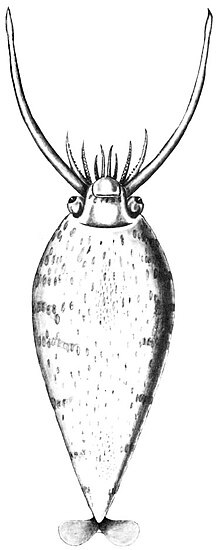Helicocranchia pfefferi: Difference between revisions
Traveler100 (talk | contribs) commonscat |
Mgiganteus1 (talk | contribs) →Physical characteristics: wikilinked gladius |
||
| Line 16: | Line 16: | ||
== Physical characteristics == |
== Physical characteristics == |
||
The average size of adult ''H. pfefferi'' is 100 mm in [[mantle (mollusc)|mantle]] length (ML). The body consists of a large [[Hyponome|funnel]] with small paddle-like fins. They have small [[tentacle]]s above their eyes. The funnel does not have valves but contains a dorsal pad with three papillae as organs.{{Fact|date=October 2008}} Paddle-shaped fins are attached to a part of the gladius. ''H. pfefferi'' has a single ocular [[photophore]] and does not have photophores at its [[cephalopod arm|arm]] tips. |
The average size of adult ''H. pfefferi'' is 100 mm in [[mantle (mollusc)|mantle]] length (ML). The body consists of a large [[Hyponome|funnel]] with small paddle-like fins. They have small [[tentacle]]s above their eyes. The funnel does not have valves but contains a dorsal pad with three papillae as organs.{{Fact|date=October 2008}} Paddle-shaped fins are attached to a part of the [[Gladius (cephalopod)|gladius]]. ''H. pfefferi'' has a single ocular [[photophore]] and does not have photophores at its [[cephalopod arm|arm]] tips. |
||
== Habitat == |
== Habitat == |
||
Revision as of 00:18, 6 January 2012
| Banded Piglet Squid | |
|---|---|

| |
| Ventral view of a specimen taken off Southern California (41 mm ML) | |
| Scientific classification | |
| Kingdom: | |
| Phylum: | |
| Class: | |
| Order: | |
| Family: | |
| Genus: | |
| Species: | H. pfefferi
|
| Binomial name | |
| Helicocranchia pfefferi Massy, 1907
| |
The Banded Piglet Squid (Helicocranchia pfefferi) is a small squid of the genus Helicocranchia. Adults of this species are mesopelaegic.
Physical characteristics
The average size of adult H. pfefferi is 100 mm in mantle length (ML). The body consists of a large funnel with small paddle-like fins. They have small tentacles above their eyes. The funnel does not have valves but contains a dorsal pad with three papillae as organs.[citation needed] Paddle-shaped fins are attached to a part of the gladius. H. pfefferi has a single ocular photophore and does not have photophores at its arm tips.
Habitat
As paralarvae (<30 mm ML), they live near the surface of the oceans, between 100 m and 200 m deep. They descend to the mesopelagic zone as they mature, but do not exhibit a diel vertical migration pattern. [1]
References
- ^ Lu, C.C. & M.R. Clarke (1975). "Vertical Distribution of Cephalopods at 11° N 20° W in the North Atlantic". Journal of the Marine Biological Association of the United Kingdom. 55 (2): 369–389. doi:10.1017/S0025315400016003.
- Young, R.E. & K.M. Mangold (1922-2003). 2006. Helicocranchia Massy, 1907. Version 16 July 2006 (under construction). In: The Tree of Life Web Project.
External links
- "CephBase: Helicocranchia pfefferi". Archived from the original on 2005-08-17.
- Images of Helicocranchia from the SERPENT Project
- Blog post with lots of information
